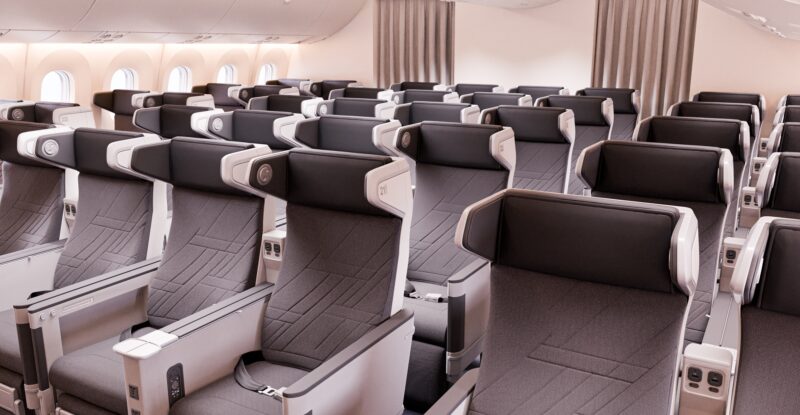Aerospace giant Safran delivered bumper earnings results for the first half of 2025, as each of its divisions — propulsion, equipment & defense, and aircraft interiors — saw organic revenues surge: 16.9%, 8% and 15.5% year-over-year, respectively.
This growth was achieved despite ongoing supply chain constraints in industry, including around aircraft engine and interior components.
Aircraft Interiors
After returning to profitability in 2024, Safran’s aircraft interiors division saw continued momentum in the first six months of 2025. Original equipment sales of aircraft interiors grew 14.4%, mainly driven by seats, with Safran observing a “significant increase” in business class seat deliveries. For context, the Paris-headquartered firm delivered 1,238 business class seating units in the first six months of the year versus 750 for the same period in 2024.
In June, Safran announced on LinkedIn that SkyTeam alliance member Air France has tapped its Safran Seats business to equip a further 18 Boeing 777-300ERs with new doored mini-suites for business class.
But many of Safran’s premium seating awards — and indeed its inflight entertainment and connectivity wins — are never publicly disclosed. For example, the RAVE IFE system produced by Safran Passenger Innovations is enjoying a growing footprint at Etihad Airways, with an Etihad spokesperson confirming to RGN that RAVE is “installed on select 787 and A350 aircraft” — in addition to the carrier’s new A321LR, which was recently pressed into service on flights to Phuket.
In another example, Korean Air is gearing up to debut its new Premium Class product on retrofitted Boeing 777-300ER aircraft in mid-September on short- and medium-haul routes. A Korean Air spokesperson confirms to RGN that the new product (pictured above) is based on Safran’s Z535i platform. The Z535i is also understood to be the basis for EVA Air’s new Premium Economy product aboard the Boeing 787-9. In both instances, the airlines have touted the extraordinary legroom facilitated by the seat.
Within the aircraft interiors division, Safran also saw aftermarket activities grow by 17.3% year-over-year during the first half of 2025. This was driven mostly by spare parts for aircraft cabins. Moreover, cabin deliveries — constituting galleys, galley inserts and the like — also increased, though to a lesser extent, the firm noted.
Propulsion
Flying high during the first half of 2025, Safran’s propulsion division saw robust civil engine aftermarket activities which drove “a record operating margin of 17% as well as unprecedented cash generation” at the firm, CEO Olivier Andriès said in a statement.
Safran builds LEAP engines for the Boeing 737 MAX, Airbus A320neo and Comac C919 aircraft via its CFM International joint venture with GE Aerospace. Both Airbus and Boeing are in the process of ramping up production of the 737 MAX and A320neo families, respectively, but Airbus recently flagged a concern that there remains a high level of produced commercial aircraft awaiting engines.
In the face of supply chain bottlenecks, LEAP engine deliveries increased by 10% to 729 units in the six months through 30 June compared to 664 for the same period in 2024.
While the CFM joint venture stopped producing the popular CFM56 powerplant for commercial customers in 2020, the business for spare parts is strong. Indeed, spare parts for civil engines increased by 21.6% over the six-month period, driven primarily by CFM56, but with “a positive contribution from high-thrust engines and LEAP,” Safran said.
Equipment & Defense
Within the Equipment & Defense division, Safran delivers landing gear to both the Airbus A320neo and Boeing 787 programs. Higher volumes of deliveries to these programs contributed to Safran’s original equipment sales growth of 5.5% during the first half, alongside a bump in defense activities. Aftermarket services rose by 11.9%, with growth across the board, particularly in landing systems.
For the first half of 2025, total revenue for Safran stood at EUR 14.7 billion, up 13.2% year-over-year. Recurring operating income reached EUR 2.51 billion, representing a substantial 27.2% year-on-year increase.
2025 outlook
“In the light of this strong performance, we are raising our full-year guidance on all metrics and reiterate our confidence in our mid-term outlook,” Andriès said.
Excluding the contribution of Collins Aerospace’s actuation & flight controls business, which Safran acquired in July, as well as any potential impact of tariffs, the firm expects revenue growth to be in the “low-teens” for 2025, versus its prior guidance of 10%.
Related Articles:
- Etihad takes first A321LR with three classes and Safran seatback IFE
- RAVE new world: Safran pairs PED casting with edge caching for IFE
- Air France continues 777-300ER refresh with order for Safran seats
Featured image credited to Korean Air












